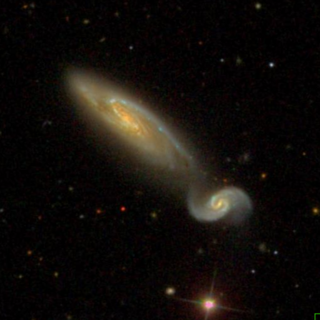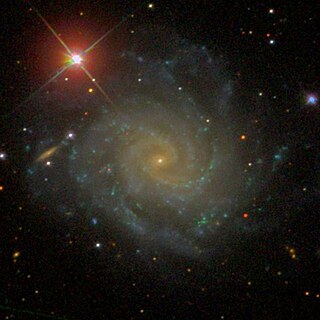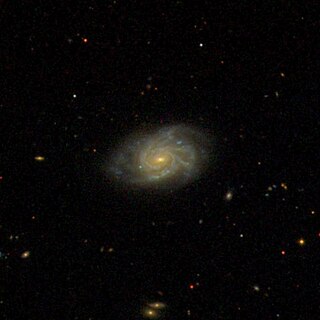
NGC 3982(also known as UGC 6918) is an intermediate spiral galaxy approximately 68 million light-years away in the constellation Ursa Major. It was discovered by William Herschel on April 14, 1789, and misclassified as a planetary nebula. NGC 3982 is a part of the M109 Group.

NGC 4873 is a lenticular galaxy located about 270 million light-years away in the constellation of Coma Berenices. NGC 4873 was discovered by astronomer Heinrich d'Arrest on May 10, 1863. The galaxy is a member of the Coma Cluster.

NGC 6061 is a lenticular galaxy with radio activity located about 490 million light-years away in the constellation Hercules. The galaxy is classified as a head-tail radio galaxy and was discovered by astronomer Lewis Swift on June 8, 1886. NGC 6061 is a member of the Hercules Cluster.

NGC 4694 is a lenticular galaxy in the constellation Virgo. Its velocity with respect to the cosmic microwave background is 1481 ± 23 km/s, which corresponds to a Hubble distance of 71.3 ± 5.1 Mly (21.85 ± 1.57 Mpc). However, six non redshift measurements give a distance of 28.51 ± 7.23 Mly (8.742 ± 2.218 Mpc). The galaxy was discovered by William Herschel on March 15, 1784.

NGC 918 is a barred spiral galaxy in the constellation Aries, about 67 million light years from the Milky Way. It was discovered by John Herschel on Jan 11, 1831.

NGC 5486 is an irregular galaxy in the constellation Ursa Major 110 million light-years from Earth.

NGC 3800 is an intermediate spiral galaxy located in the constellation Leo. Its speed relative to the cosmic microwave background is 3,653 ± 24 km/s, which corresponds to a Hubble distance of 53.9 ± 3.8 Mpc. NGC 3800 was discovered by German-British astronomer William Herschel in 1784.

NGC 2008 is a distant spiral galaxy located in the constellation Pictor. Its speed relative to the cosmic microwave background is 10,367 ± 11 km/s, which corresponds to a Hubble distance of 153 ± 11 Mpc. NGC 2008 was discovered by British astronomer John Herschel in 1834. The luminosity class of NGC 2008 is III with an apparent magnitude of 13.2.

NGC 4712 is a spiral galaxy located in the constellation Coma Berenices. Its speed relative to the cosmic microwave background is 4,664 ± 20 km/s, which corresponds to a Hubble distance of 68.8 ± 4.8 Mpc. NGC 4712 was discovered by German-British astronomer John Herschel in 1832.

NGC 5885 is an intermediate barred spiral galaxy located in the constellation Libra. Its speed relative to the cosmic microwave background is 2,185 ± 13 km/s, which corresponds to a Hubble distance of 32.3 ± 2.3 Mpc. NGC 5885 was discovered by German-British astronomer William Herschel in 1784.

NGC 1024 is a large spiral galaxy of type Sab located in the constellation Aries. Its speed relative to the cosmic microwave background is 3,306 ± 16 km/s, which corresponds to a Hubble distance of 48.8 ± 3.4 Mpc. NGC 1024 was discovered by German-British astronomer William Herschel in 1786.

NGC 3200 is a large spiral galaxy located in the constellation Hydra. Its velocity relative to the cosmic microwave background is 3,877 ± 25 km/s, which corresponds to a Hubble distance of 57.2 ± 4.0 Mpc. NGC 3200 was discovered by American astronomer Edward Singleton Holden in 1882.

NGC 2648 is a spiral galaxy located in the constellation Cancer. Its speed relative to the cosmic microwave background is 2,451 ± 19 km/s, which corresponds to a Hubble distance of 36.2 ± 2.6 Mpc. NGC 2648 was discovered by German-British astronomer William Herschel in 1784.

NGC 7716 is an intermediate spiral galaxy located in the constellation Pisces. Its speed relative to the cosmic microwave background is 2,201 ± 26 km/s, which corresponds to a Hubble distance of 32.5 ± 2.3 Mpc. NGC 7716 was discovered by British astronomer John Herschel in 1831.

NGC 1175, also known as the Peanut Galaxy, is a large lenticular galaxy located in the constellation Perseus. Its speed relative to the cosmic microwave background is 5,349 ± 19 km/s, which corresponds to a Hubble distance of 78.9 ± 5.5 Mpc. It was discovered by the German-British astronomer William Herschel in 1786.

NGC 1340 is an elliptical galaxy located in the constellation Fornax. Its speed relative to the cosmic microwave background is 1,126 ± 17 km/s, which corresponds to a Hubble Distance of 16.6 ± 1.2 Mpc. It was discovered by the German-British astronomer William Herschel in 1790, but it was added to the New General Catalog under the designation NGC 1344 later.

NGC 5416 is a spiral galaxy and radio galaxy located in the constellation Boötes. Its speed relative to the cosmic microwave background is 6,499 ± 18 km/s, which corresponds to a Hubble distance of 95.9 ± 6.7 Mpc. NGC 5416 was discovered by German-British astronomer William Herschel in 1784.

NGC 3177 is a spiral galaxy located in the constellation Leo. Its speed relative to the cosmic microwave background is 1,627 ± 22 km/s, which corresponds to a Hubble distance of 24.0 ± 1.7 Mpc. NGC 3177 was discovered by the German-British astronomer William Herschel in 1784.

NGC 633 is a large barred spiral galaxy located in the constellation Sculptor. Its speed relative to the cosmic microwave background is 4,979 ± 18 km/s, which corresponds to a Hubble distance of 73.4 ± 5.2 Mpc. NGC 633 was discovered by British astronomer John Herschel in 1834.

NGC 5377 is an intermediate barred spiral galaxy located in the constellation Canes Venatici. Its speed relative to the cosmic microwave background is 1,951 ± 11 km/s, which corresponds to a Hubble distance of 28.8 ± 2.0 Mpc. NGC 5377 was discovered by German-British astronomer William Herschel in 1787.




















